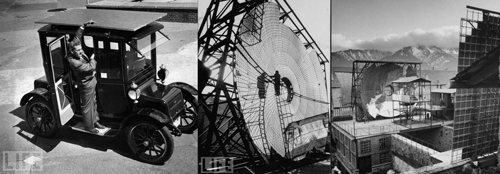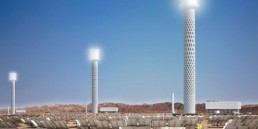Great historic shots of early solar power technology in this photo essay.
Seems that if we hadn’t had been so “lucky” to have had “inexpensive” access during the 20th century to ready supplies of fossil fuels, we would have come a whole lot further with solar power in the last 60 years. As it is, the technology then seems quite familiar to that being employed today.
Some quotes from the LIFE piece:
In 1960, Dr. Charles A. Escoffery discusses the solar-powered car he invented. The 1912 “Baker Electric Mode” featured 26 square feet of silicon cells on its roof.
More benign uses for solar energy and power have always been on scientists’ and inventors’ radar, i.e., this solar distiller, used to draw fresh water out of salt water, demonstrated at an international conference on solar energy in 1955.
The main mirror (flat, foreground) and the parabolic mirror of a French “solar furnace” built atop a 17th century fortress in the 1950s. The main mirror — a 43-foot X 34-foot giant — deflects rays of sunlight to the 31-foot parabolic shell, which then focuses the sunlight even further, intensifying it to a point where it generates temperatures in excess of 5,000 degrees Fahrenheit.
A Ralph Morse photograph of what LIFE celebrated as the “world’s first sun-heated home” in a 1949 issue of the magazine — a house in Dover, Mass., that featured an enormous “heat trap” consisting of two separated panes of glass with a black metal panel between them. “The sun’s short heat waves go through the glass and warm the metal to as much as 150 degrees. At this temperature the metal gives off long heat waves that can not easily go back out through the glass.” Fans then circulated the trapped warmth through the home — not doing away with the need for electricity, of course, but in the words of the article, “it could be the beginning of a big reduction in the approximately $3.5 billion the U.S. pays annually for household fuel.” [Emphasis added, for editorial effect.]
Related Posts
1 Comment
Add comment Cancel reply
This site uses Akismet to reduce spam. Learn how your comment data is processed.



[…] PhotoEscoffery modified what was already a pretty old car in 1960 with 26 square feet of solar cells, according to a period Life article excerpted on the Land Art Generator Initiative […]